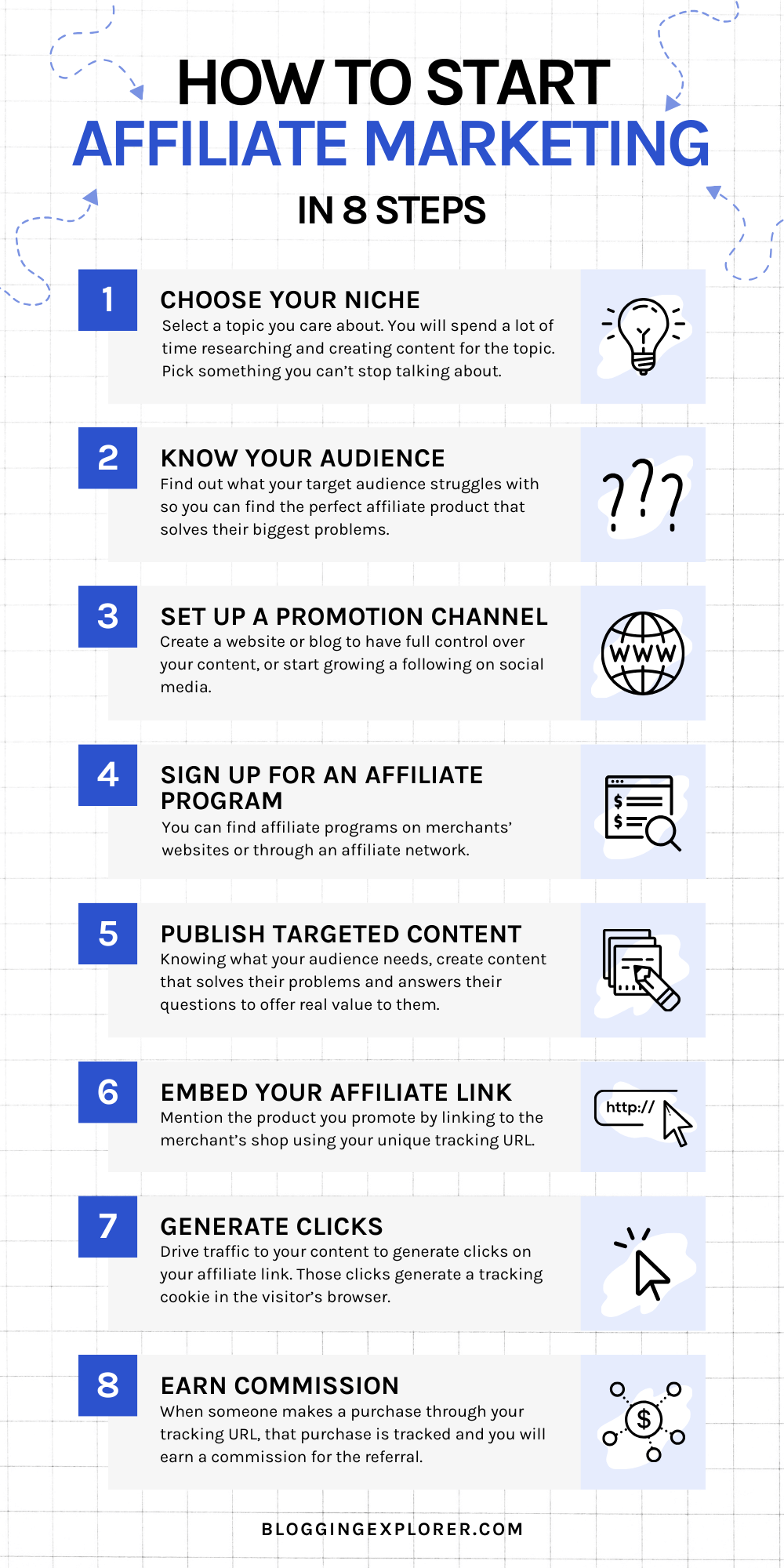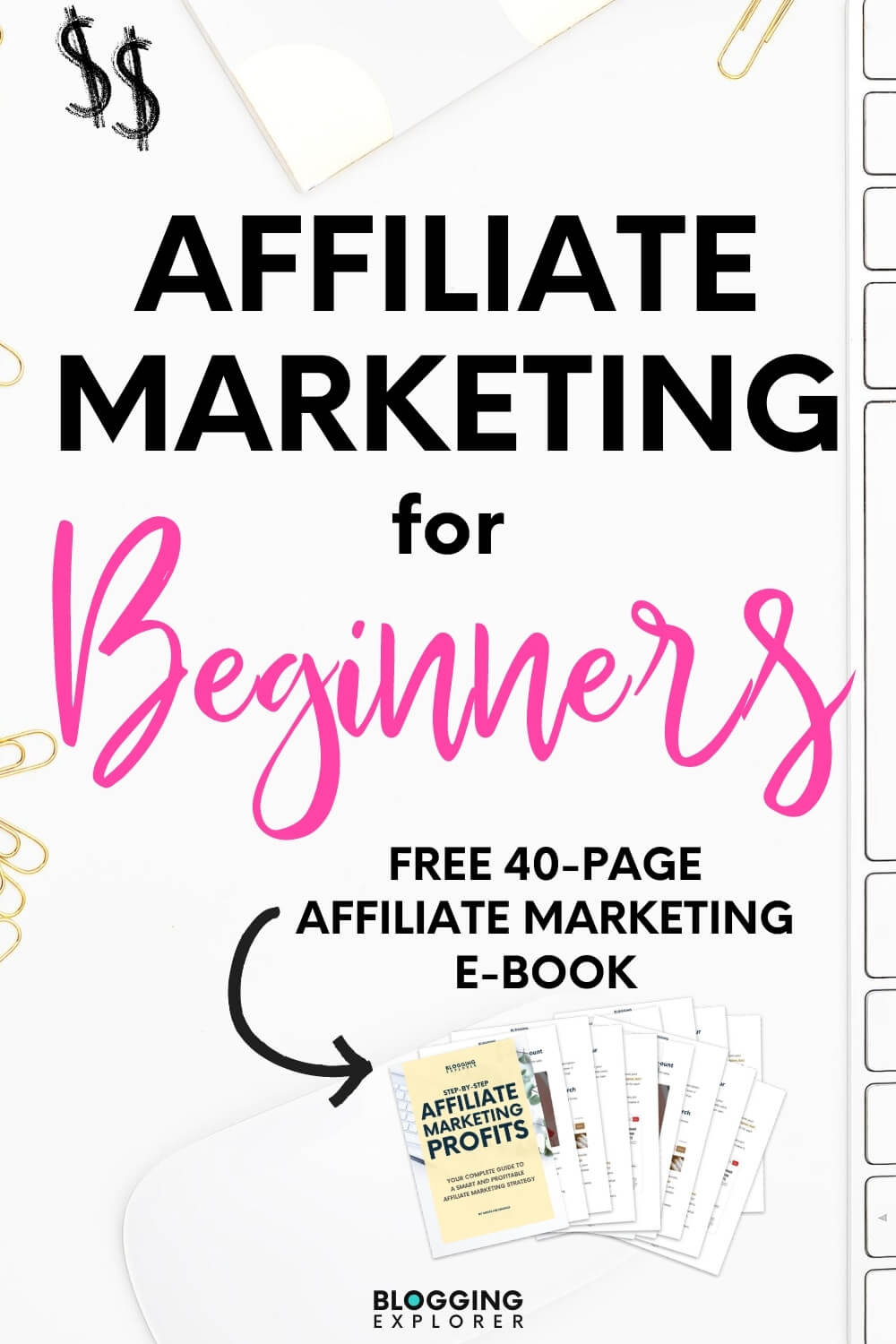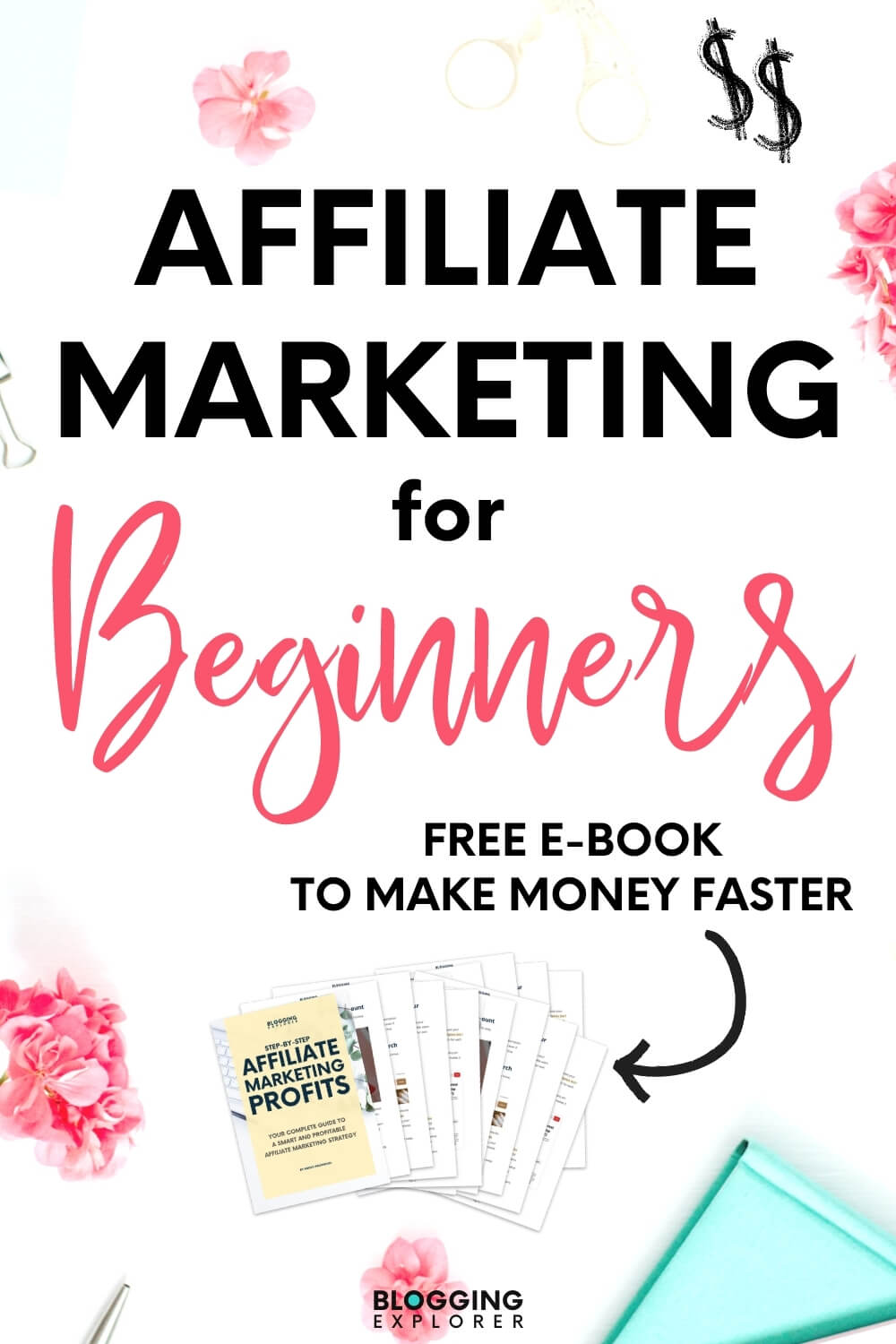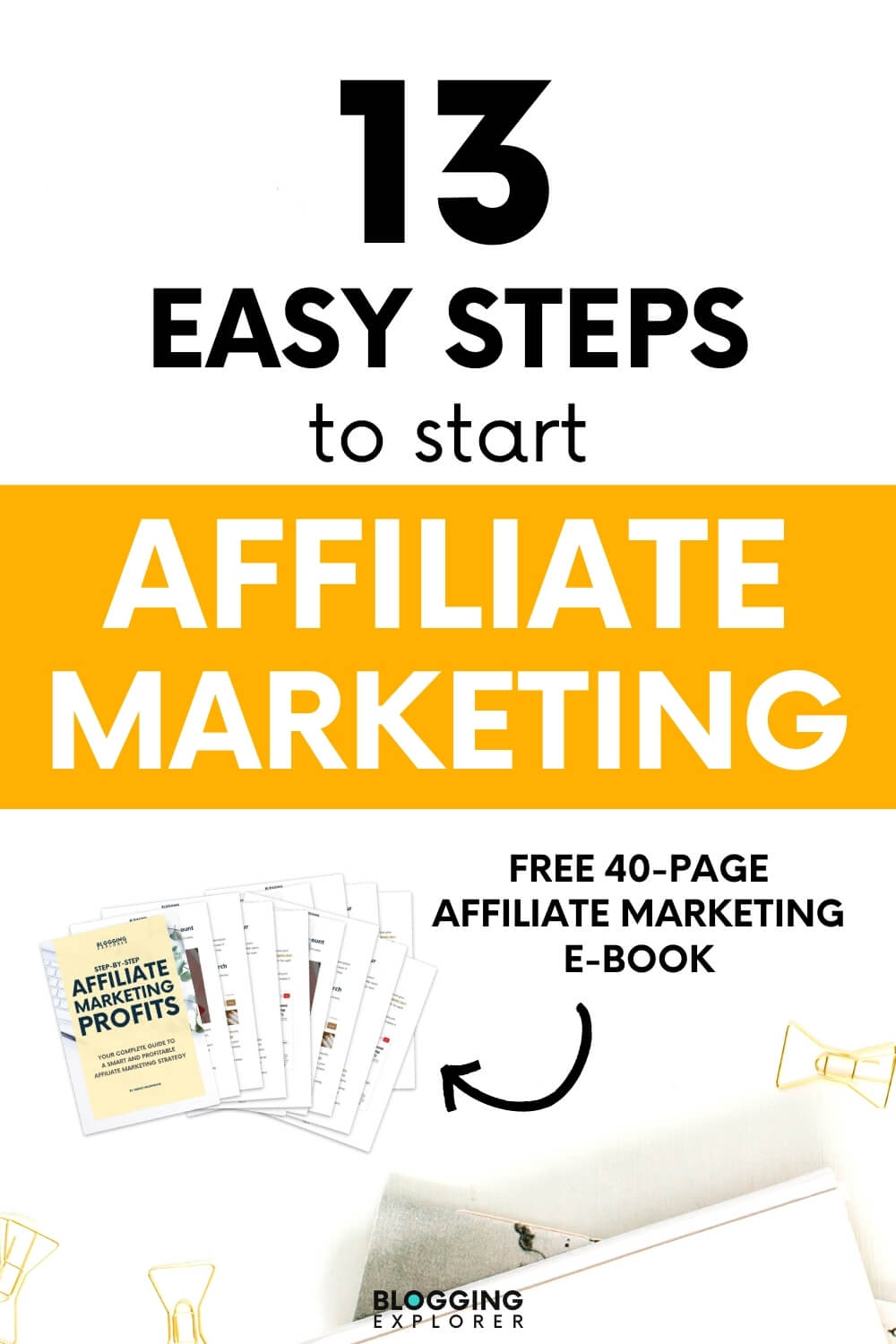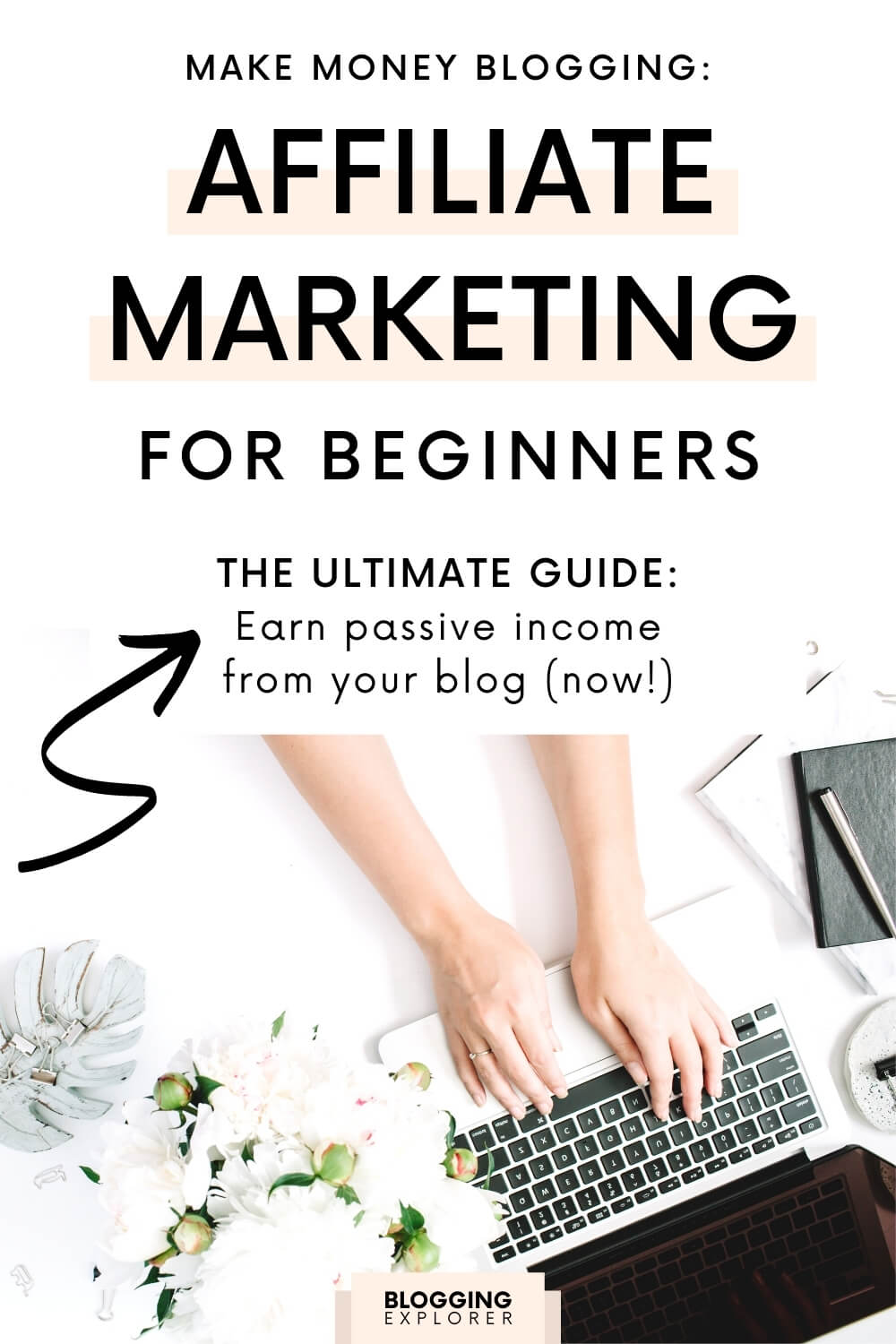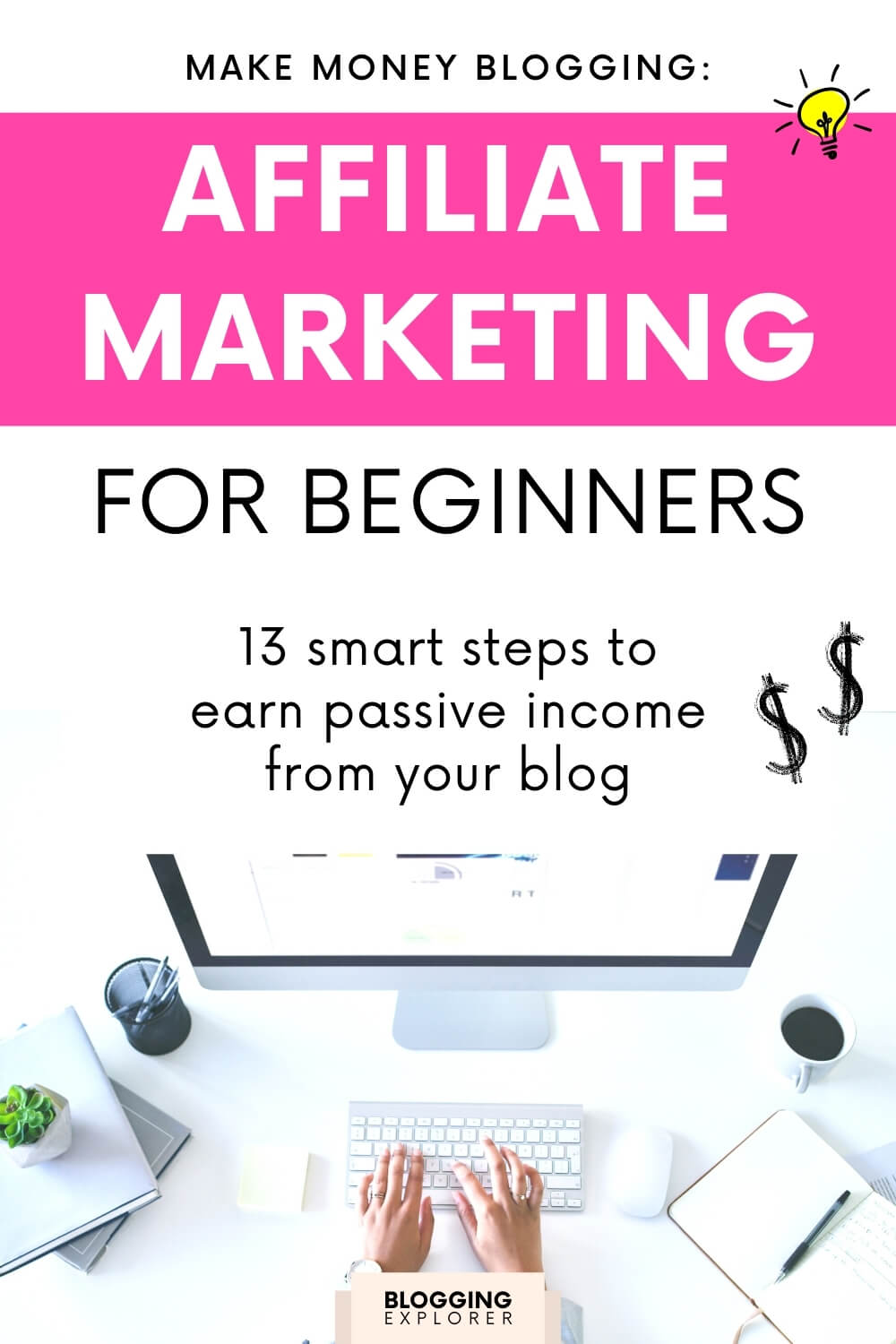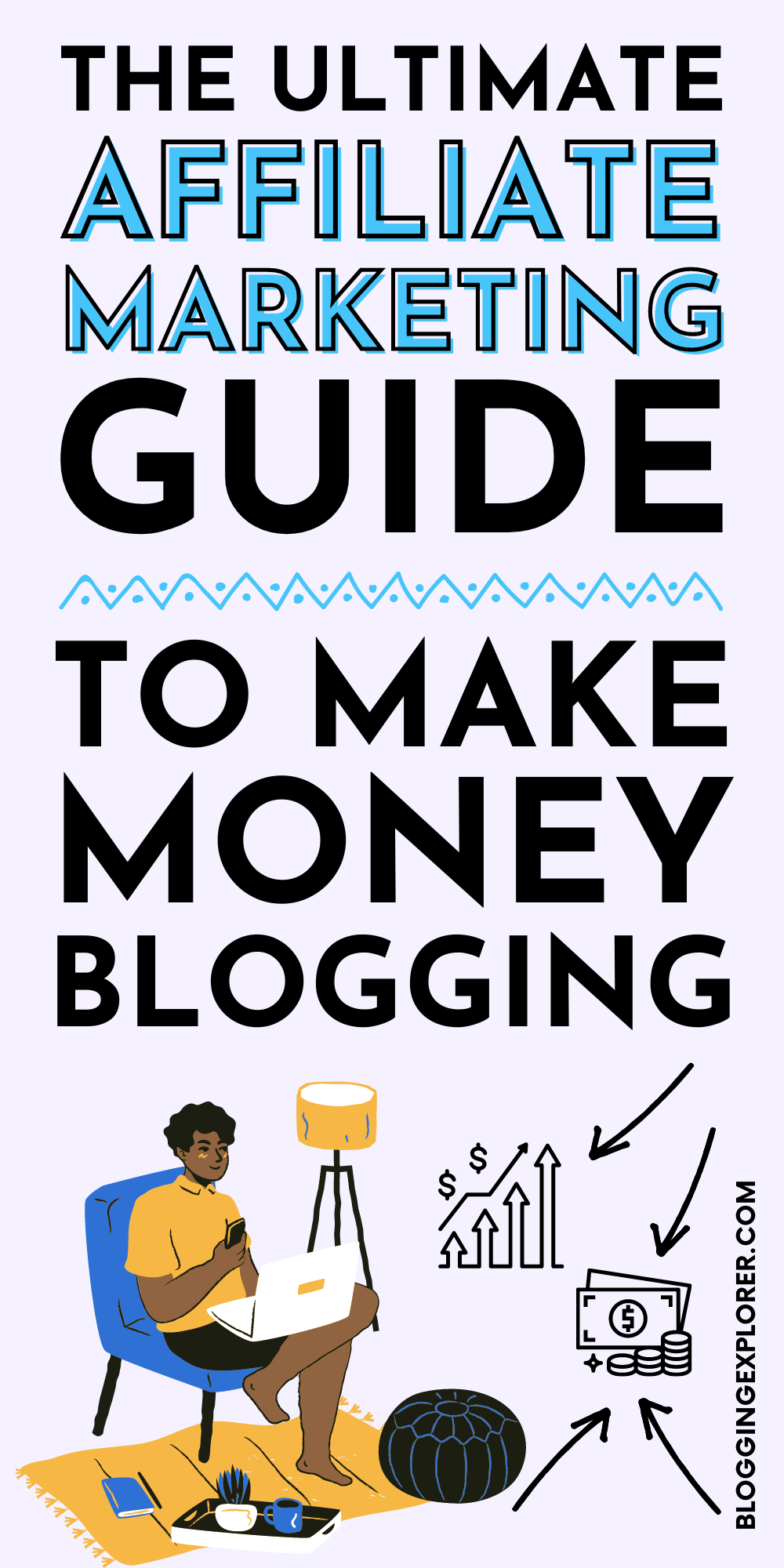When I launched this blog in late 2018, I was determined to make money blogging online.
I was already familiar with blogging basics. But I wasn’t sure what was the best way to earn passive income.
So, I did some research and found three potential ways to monetize my blog:
- Affiliate marketing
- Selling my own products
- Using display ads
I was new to affiliate marketing and didn’t know much about it.
I had tried affiliate marketing on my first blog. But my income wasn’t where I wanted it to be.
Fast forward to 2020, and I was already making a full-time income blogging. Since then, 85% of my blog income comes from affiliate marketing.
That’s why I’m sharing my experience and strategies in this “Affiliate Marketing for Dummies” guide!
In my first month, Blogging Explorer earned a modest $162 in affiliate income.
May not feel like much, but I was so proud of what I had achieved!
I felt like I had finally figured out the secrets to successful affiliate marketing! (Ha!)
But I was determined to learn as much as possible about affiliate marketing for dummies (read: beginners!) and bloggers and take my income to the next level.
So I read e-books, did market research, found the best affiliate products to promote, and took notes of everything I learned.
In March 2019, just three months later, I made:
$1,112
with affiliate marketing alone.
The best part?
I took notes of everything I learned and all the strategies I used. And I’m going to share them all with you in this guide.
Let’s get started!
Related articles you may be interested in:
- How to Monetize Your Blog? 5 Powerful Ways to Make Money Blogging
- Start Earning Passive Income With Ads on Your Blog: Beginner’s Guide
- How Much Does It REALLY Cost to Start a Profitable Blog?
Disclosure: This page contains affiliate links, meaning I receive a commission if you decide to purchase using my links, but at no additional cost to you. Please read my disclosure for more information.
- What is affiliate marketing?
- The affiliate marketing system: 4 main parts
- Affiliate marketing for dummies: The ultimate step-by-step guide
- 1: Choose your niche
- 2: Create your website
- 3: List the brands and products you love
- 4: Choose products you use and trust
- 5: Focus on a specific product category
- 6: Sign up for the best affiliate marketing programs for beginners
- 7: Choose the best channel to promote your affiliate products
- 8: Create content to promote your affiliate product
- 9: Find alternative affiliate products
- 10: Create a round-up of all products you recommend
- 11: Use short affiliate links
- 12: Make it clear you use affiliate links
- 13: Start driving traffic to your content
- Summing it up: Affiliate marketing for dummies step-by-step guide
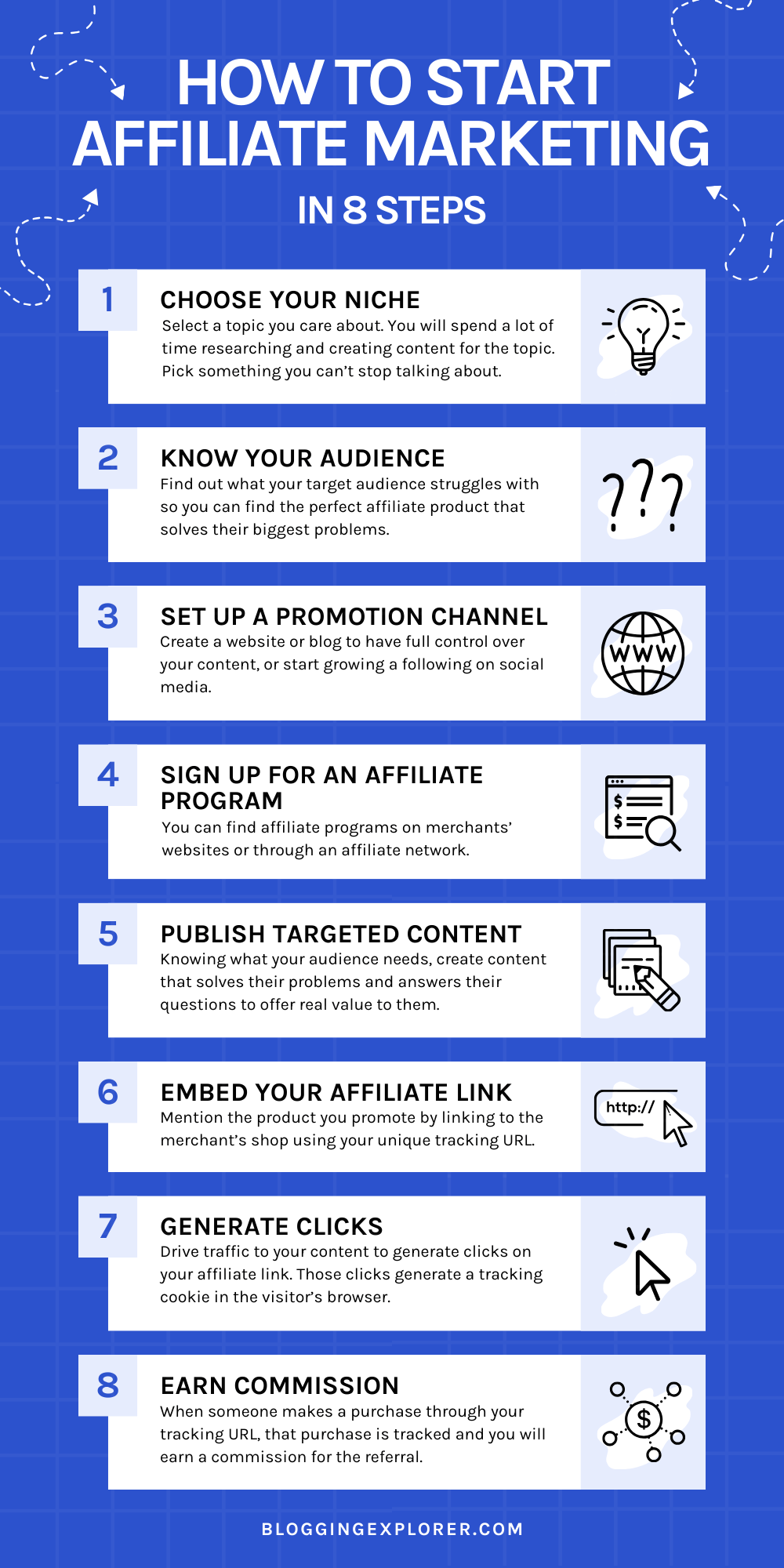
What is affiliate marketing?
You’re looking to earn passive income online, and you want to get started with affiliate marketing?
Awesome!
But if you’re entirely new to it all, you’re probably asking: How does affiliate marketing work exactly?
The idea behind affiliate marketing is simple: you promote and sell other people’s products.
If people end up buying the product thanks to your marketing, you earn a commission for every purchase.
With that said, there are two ways you can make money with affiliate marketing:
- If you have no product of your own, you can promote a product you trust and love and earn passive income as an affiliate marketer.
- If you have a product and want to sell more, you can set up an affiliate program and offer others an incentive for promoting your product.
In other words, affiliate marketing is a way to separate (1) product creation from (2) product marketing.
Most bloggers and content creators start affiliate marketing by promoting and selling other people’s products.
But although you will save the time it takes to create a product, this path requires a lot of work.
Your main challenge is to attract enough visitors to your blog to generate enough sales for a decent commission income.
The affiliate marketing system: 4 main parts
If you want to make money with affiliate marketing, you need to understand how the system works.
The affiliate marketing system has 4 main parts:
1: The merchant
The merchant someone who wants to sell a product. It can be a big corporation, a small local business, or an individual like yourself.
If you create your own digital product, you can set up an affiliate program and let others promote it.
2: The affiliate
The affiliate does the marketing for the product.
Their task is to convince potential buyers of the benefits and value of the product.
If someone purchases a product through the affiliate, the affiliate earns a commission.
For example, I’m an affiliate for a few products I’ve used to grow my blogging business.
To help my visitors find all the tools I use, I’ve listed them on my Blogging Tools and Resources page:
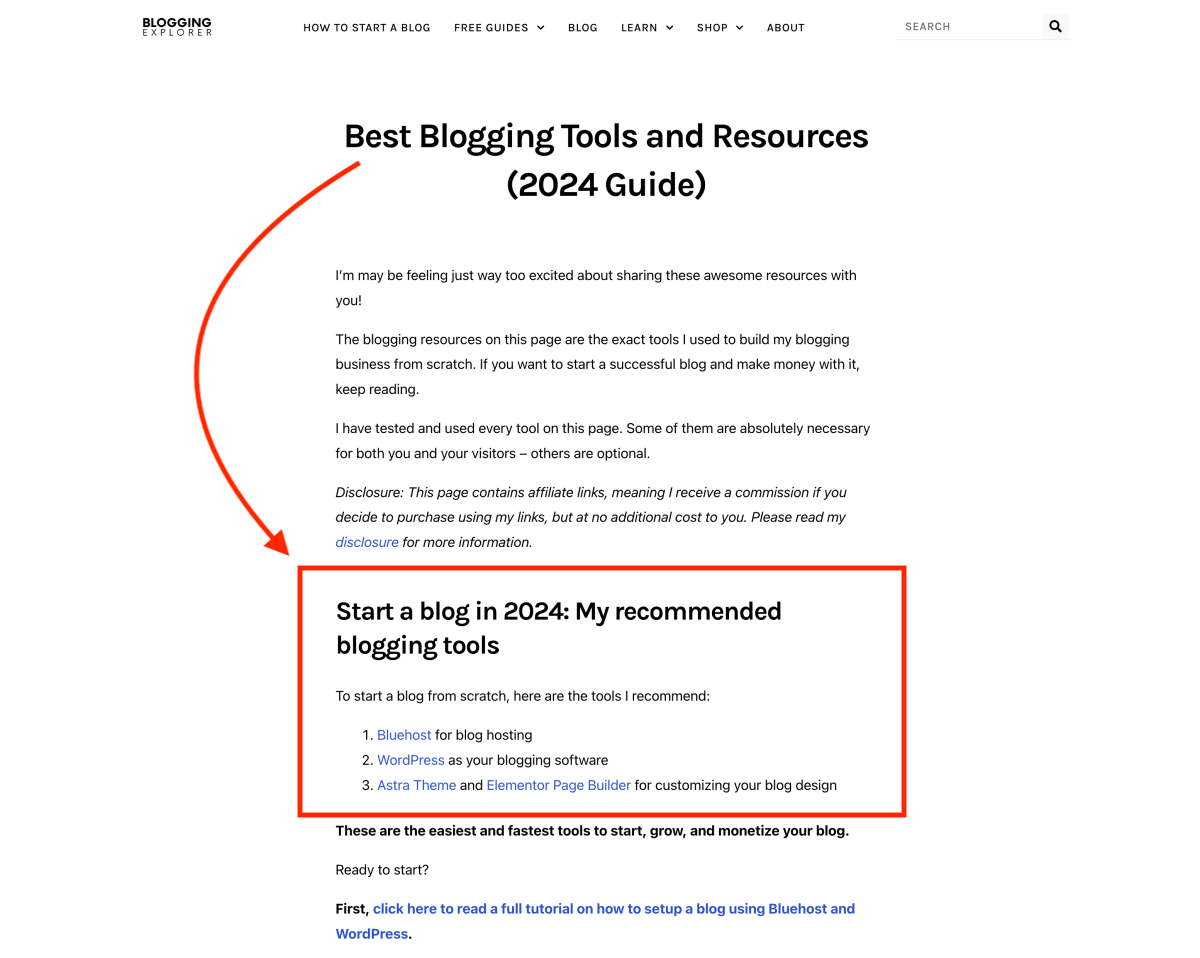
When other bloggers find a helpful resource and make a purchase through my link, I earn a small commission.
Thus, I help other bloggers find useful tools I trust, and there is no extra cost to the buyer.
To get this setup working, we need affiliate networks. Let’s have a look:
3: The network
Affiliate networks are the “match-makers” in the affiliate marketing system. They pair merchants with affiliates and act as an intermediary.
Networks manage the technical part of merchants’ affiliate programs. They track purchases and make sure commissions are paid out correctly.
A single network can manage thousands of individual affiliate programs and products.
Once an affiliate joins a network, they can easily find affiliate products to promote.

4: The customer
Customers or consumers are the driving force of the entire affiliate marketing system. If they don’t make a purchase, no commissions will be generated.
Therefore, the affiliate needs to make sure that the customer finds the best, most relevant products they need.
The customer doesn’t pay a higher price for the affiliate product. Some merchants even offer discounts for purchases through affiliate partners.
Now you know how the affiliate marketing system works, yay!
Putting it all together: How affiliate marketing works
Here’s a quick recap on how affiliate marketing works:
- The affiliate signs up for a merchant’s affiliate program or an affiliate network
- The affiliate uses their unique tracking URL when mentioning the merchant’s product
- The customer visits the affiliate’s website, blog, or social media
- The customer clicks on the affiliate’s tracking link to visit the merchant’s site
- A tracking cookie is saved in the customer’s web browser
- The customer makes a purchase in the merchant’s shop
- The merchant detects the tracking cookie and credits the sale to the referring affiliate
- The affiliate earns a commission for the referral
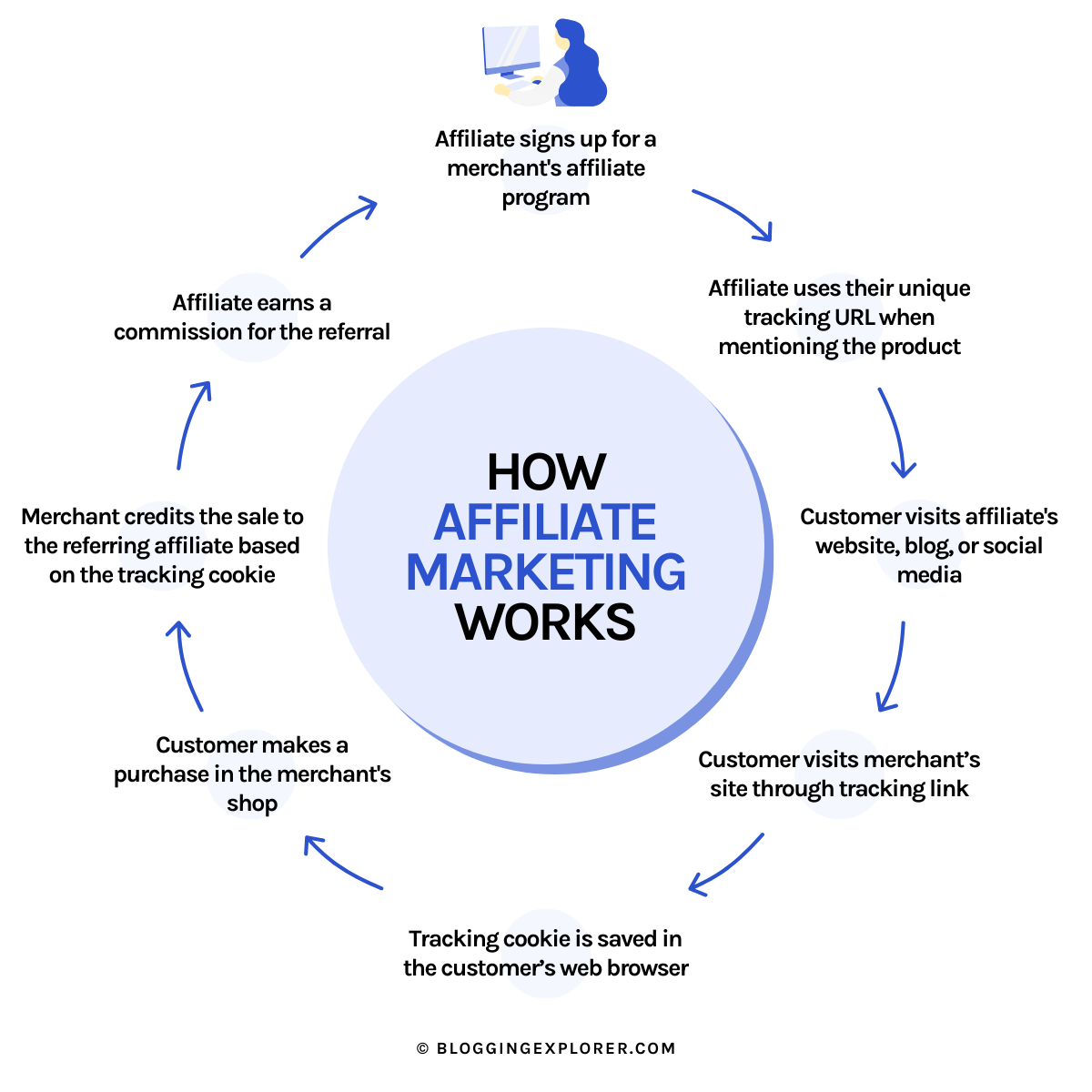
Next, let’s see how you can get started with affiliate marketing and earn your first commissions.
Affiliate marketing for dummies: The ultimate step-by-step guide
So, now you’re ready to start building your affiliate marketing business and earn your first commissions quicker than you expect.
I’m going to walk you through all the steps you need to take to become a successful affiliate marketer and make money online.
Just make sure you don’t skip anything. Follow this affiliate marketing for dummies guide one step at a time. I’m here to guide you through it so that you can steal my proven strategies right away!
This guide is long! Share it and pin it for later!
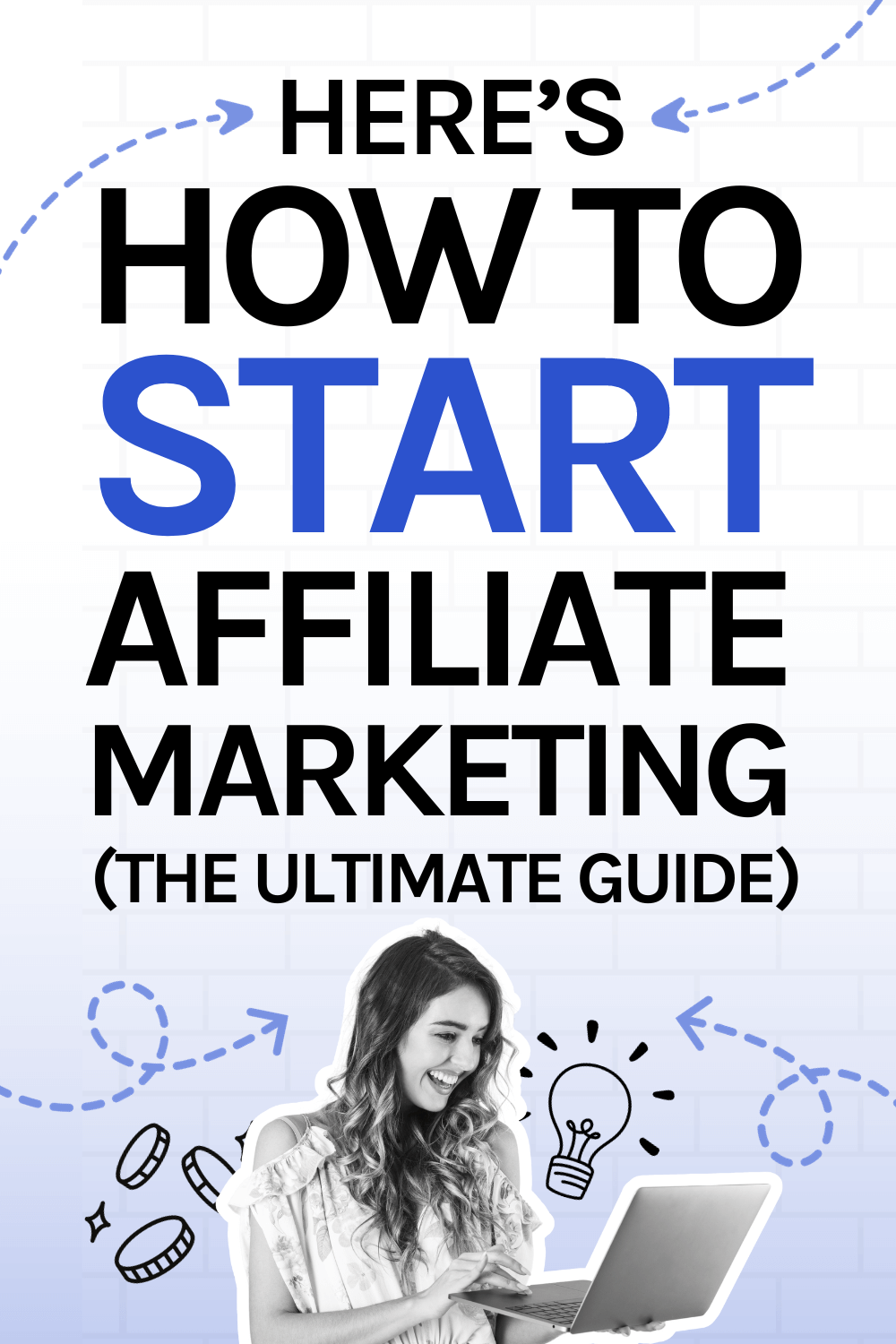
1: Choose your niche
The first thing you need to do is to choose a niche you will target with your affiliate website or blog.
A niche is simply a target market. Ideally, there’s enough demand for your affiliate products in that niche, so that enough people will visit your website and convert into buyers.
However, you don’t want to target a niche that’s too broad. The more specific your niche is, the easier it will be to reach the right audience who’s interested in what you have to say.
Also, choosing a highly focused niche will help you rank well on Google. That way, you can expect to generate free, organic traffic to your website.
Here are a few questions you can answer to find the perfect niche:
What are you passionate about?
If you want to learn affiliate marketing for dummies and make money online, you will spend a lot of time researching and creating content about your topic.
All that work will be much easier if you choose a niche you genuinely enjoy working in.
What’s the one thing you can’t stop talking about?
If you’re not sure about your passion, think about topics you love discussing with other people.
If you can’t stop talking about a particular topic, it might be the perfect niche for you.
Also, go through your browser history to see what websites you visit frequently.
Can you make money in your niche?
Being passionate about a niche is great.
But what’s equally important is whether you can monetize it.
I know you want to make money with affiliate marketing. That’s the whole point of this guide!
To achieve your goal, you need to find a niche that allows you to earn commissions.
Do you know your niche well enough?
The only way to make money with affiliate marketing is to choose a niche you know well enough.
You don’t want to recommend products you haven’t tried yourself.
After all, you want to help others with your experience with those products. Thus, you need to be absolutely sure that they are useful to your audience.
For a full guide, check out my article on how to choose the perfect niche for your blog or website.
2: Create your website
The next step for understanding affiliate marketing for dummies is to build your blog or website!
If you already have a website, good job! Feel free to skip to Step 3.
If you haven’t launched a website yet, don’t worry. Take your findings from Step 1, and I’ll show you precisely what you need to do.
You don’t need any experience with launching a website for this.
The first thing you need to know before we start is:
If you want to make money from affiliate marketing with your website, your website needs to be self-hosted on a web server that allows you to customize it freely.
Self-hosting your site means you have full control over everything you do.
But more importantly, you will own your self-hosted website content.
If you use a free website platform, your site could be shut down any time without warning. You will lose your content, traffic, and income, so all your hard efforts will be lost.
Here are the steps you need to follow to set up your blog website the right way:
Step 1: Choose a domain name
Domain name simply means your website’s name.
It’s the URL people see in their web browsers.
Here are my tips for choosing your domain name:
- Keep it short
- Make it easy to spell and remember
- Include a keyword related to your niche
Of course, your domain needs to be available.
You can easily check the availability with Bluehost’s domain tool.

Step 2: Use the right website platform
Use WordPress.org as your website and blog platform. It’s the most popular website software worldwide.
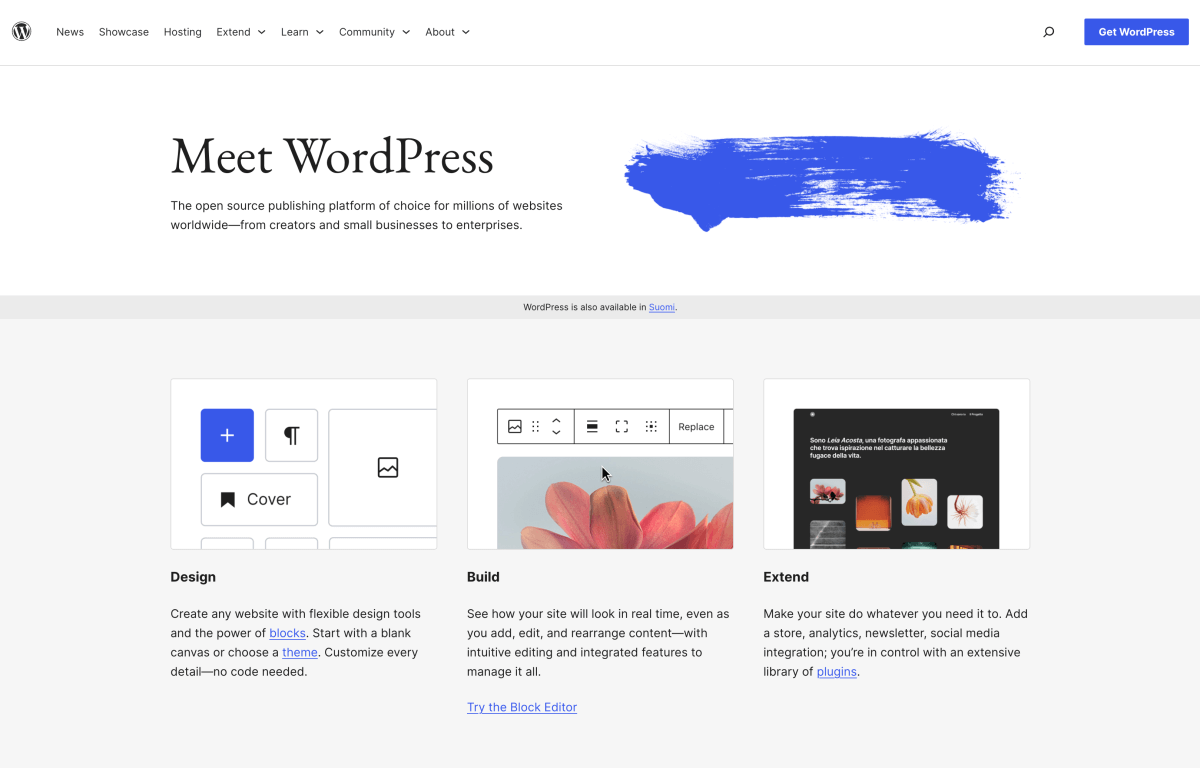
Also, it’s free to use and you can customize your website freely with the best WordPress themes for bloggers and small business owners.
I use WordPress for all my blogs, websites, and all the projects I build for my clients as a freelance web developer.
WordPress.org is free. But you will need a web server to host the files with a web hosting provider.
Web hosting is the only thing you need to invest money in at this point.
Spending a few bucks here is necessary because you won’t be able to use all affiliate programs if you make the wrong choice and use a free website platform.
Step 3: Buy web hosting
I use Bluehost as my web hosting provider. They keep all my website files and data stored on their web server.
That way, you and everyone else can access my blog 24/7 from anywhere in the world.
Out of all the hosting providers I’ve tried, Bluehost is the best value for your money.
The signup process is quick and easy, their plans are affordable, and you get free 24/7 support.
Plus, you also get a FREE domain for your website with Bluehost.
Sounds good?
Head over to Bluehost.com and click on Get Started Now:

Now you will see the available hosting plans and choose the right one. To get started with affiliate marketing, choose the Basic plan on the left:

Step 4: Install WordPress
Now it’s time to install the WordPress software.
If you signed up with Bluehost, they install WordPress automatically for you during the signup process.
If you are using another hosting provider, check with them how to get WordPress up and running. Most likely, they will help you install WordPress in your client dashboard.
Most hosting providers offer a 1-click installation, meaning you will only need a few minutes to get WordPress up and running.
Step 5: Choose a WordPress theme
WordPress themes allow you to customize the design and style of your website.
You can adjust:
- navigation elements and menus
- page layouts
- color schemes
- fonts and typography
You can choose from dozens of beautiful themes, both free and paid.
I use the free Hello theme together with the powerful Elementor page builder plugin on Blogging Explorer.

For more help to customize your website like a pro, check out my step-by-step guide to find the perfect WordPress theme.
3: List the brands and products you love
By now, you have selected the niche for your affiliate marketing strategy.
You have also set up a website to start creating content about your affiliate products. Good job!
Let’s move on:
The next essential thing about getting started with affiliate marketing is to find the right products to recommend and promote to your readers.
But the good news is:
There’s an affiliate program for almost all products, services, and tools you’re using.
Start by thinking about your blog niche:
- What’s your blog about?
- Who’s your ideal reader?
- How does your content help them?
- What problems can you solve? What questions can you answer?
Next, make an overview of all the products you use and love that could be relevant to your readers.
Then, simply do a Google search for each product on your list:
- “company or product name + affiliate program” or
- “company or product name + referral program”

Most often, you will find an affiliate program you can join right away.
4: Choose products you use and trust
Now that you know where to look for affiliate programs to join, it’s time to narrow down your options.
You want to make sure you only talk about products you know and use. You should feel comfortable enough with the product to answer any questions about how to use it properly.
Here’s what you could say to your audience:
“Hey, here’s how I’ve used this product and how it’s made my life easier. You can use my affiliate link and I’ll make a little bit of money if you choose to purchase this product I really love and believe in.”
Thus, only choose affiliate programs for products that you can speak from a place of authority from and that you found success with.
Each affiliate product you promote should be something you genuinely enjoy and love.
Because the truth is:
If you recommend a product that you haven’t tried, that’s not affiliate marketing. That’s just a money-making scheme that’s neither transparent nor honest towards your readers.
Your readers are much more willing to use your affiliate links if they feel like you’re being honest with them. Never promote a product that you haven’t tried just to make a quick buck off of it.
So, share your story of success with the product. Tell a story about how you found a solution within the product. As a result, readers struggling with a similar problem can identify with what you’re saying. It’s a win-win!
Not sure what your readers want from you? No problem! I’ve written a full guide on how to find your blog target audience like a pro.
5: Focus on a specific product category
OK, so you’ve found a bunch of products you use and love – great!
But if you have 10 to 15 products on your list, where should you start? What’s the best product combination to get started with affiliate marketing for you?
First, it only makes sense to choose a combination of affiliate products that are all relevant to a single reader.
You should be crystal clear about who your target audience is. Once you know their struggles, it’s easy to pick the right combo of products to promote.
The best way to get started is to choose a handful of closely related products that complement each other.
For example, if your readers are interested in baking, you could promote your favorite kitchen mixer.
Additionally, you could recommend smaller baking utensils to go with it. And while you’re at it, why not throw in your favorite flours and baking supplies?
Ideally, your reader should find several products that go well together.
After all, if you can inspire someone who’s never baked cupcakes before to start baking regularly, they will most likely be willing to order a bunch of products at once.
If you’re affiliated with a bunch of top-notch baking stuff, you can make your reader’s life easier by linking to an entire starter kit for newbies that they can order all at once.
But remember:
Don’t throw in affiliate products that have nothing to do with baking. That would only confuse your readers and decrease your credibility as an authority blogger in your niche.
For example, you don’t want to write about kitchen mixers and car dust covers in the same article. That just wouldn’t make any sense.
6: Sign up for the best affiliate marketing programs for beginners
Ok, so now you’ve found products you love and that you can promote talking from your expertise.
Now, it’s finally time to sign up with your chosen affiliate programs.
It can take some time to select the perfect affiliate marketing programs, but take your time in this process as this is an essential step in your affiliate strategy.
You can join two types of affiliate programs:
- Individual affiliate programs:
Some companies run their own affiliate platforms that you can join directly on their website. You can usually find a link in the footer, saying “Affiliate program” or “Referral program”. - Affiliate networks:
Some companies prefer to use affiliate networks or platforms. They take care of managing affiliate programs of hundreds of different companies and products under a single website. If you’re accepted into a network, it’s much easier to find additional products to promote and to track your performance in one dashboard.
The best affiliate programs I use:
These are the high-paying affiliate programs for bloggers that helped me jump from $162 a month to $1,112 in less than three months:
The best affiliate networks I use:
You can easily find large affiliate platforms to join and search for your favorite products. Here are a few of the one I’ve used and been really happy with:
- ShareASale
- Commission Junction
- Impact Radius
- Rakuten Advertising
- ClickBank
- Amazon Associates Program
When it comes to promoting consumer products, such as books, household items, and supplies, the biggest affiliate network is Amazon. Joining it lets you promote any item sold on their platform.
When you sign up, you can create a custom affiliate link to an Amazon product. When someone clicks on your link, you will earn a small commission for everything they buy on Amazon.

If you can’t find an affiliate or a referral program, it may be only available for existing customers or members.
If you can’t find any details about an affiliate program, contact the company directly.
Let them know you love their product and you feel it could help your audience. Say that you’d like to help them make more sales, and ask if there’s any incentive to promote their product.
In case they don’t have an affiliate program, don’t worry. You’ll still have other products on your list that you can make commissions with.
Also, the more requests a company receives about an affiliate program for their product, the more likely they’ll set one up.
Things you must know before joining affiliate programs:
Before you join any affiliate marketing programs, make sure you keep these points in mind:
1: You need a website with some content
During the application process for each affiliate program, you will need to fill in information about your website, traffic, niche, and target audience.
The best way to make sure you won’t get rejected is to publish at least 5 to 15 high-quality articles on your website before applying. Of course, they should be relevant to the affiliate program and your website has to look clean and professional.
2: Sometimes you will get rejected
Unfortunately, although your website looks great and you have relevant content on it, sometimes you will get rejected.
If a specific affiliate program rejects you, find an email contact and ask for more details. They will often give you specific information for improving your website or content, for example.
If you get rejected for one affiliate program, don’t let it get you down! It happens to all of us, including myself.
3: It takes time to receive payments
All affiliate programs have different payout schedules. It could take anywhere between 10 to 90 days after the end of the month to receive your payment.
Most often, affiliate products have a 30-day refund period. If someone chooses to cancel their purchase and receives a refund, you will lose your commission.
Also, most affiliate programs have a minimum payout threshold. Hence, you need to earn a certain amount in commissions before you receive a payout. The threshold can be just $5, but it could also be $50.
4: You want to track your programs and performance
Once you have joined a few affiliate programs, things can quickly feel overwhelming.
Especially when you’re new to affiliate marketing, you want to maintain a clear overview of the programs you have applied to, been accepted, or rejected.
I use Google Sheets to track my affiliate commissions for every month. It’s super easy to identify my strongest affiliate programs that way. If a specific affiliate product is performing well, I create additional content to help my readers learn more about it.
7: Choose the best channel to promote your affiliate products
Once you’ve found the products you want to promote, it’s time to think about the content you need to create. You want to find the best ways to promote affiliate links to grow your earnings.
If you have a blog, it only makes sense to write in-depth blog posts about your affiliate products. That’s what I do, and I make enough passive income to cover my living expenses.
If you’re just getting started with affiliate marketing and blogging, I’ve written a full step-by-step guide on how to start a successful blog with no experience.
In case you have a YouTube channel, create videos that help your audience. If Instagram is your main channel, leverage it to drive curious followers to your affiliate links.
Summing it up: use the most suitable channel you have to present your affiliate links naturally.
Moreover, use whatever promotional tools and channels are available to you. Just make sure it makes sense for your audience.
For example, if you promote the best web hosting provider for bloggers, but don’t have a website, how should your readers get a sense that you know what you’re talking about?
8: Create content to promote your affiliate product
Next, let’s think about how you can tie in the products you want to recommend.
If you want to make money with affiliate marketing, your content is essential to your success. And you can’t just create average content – it needs to be in-depth and top-notch.
The most important thing is to make sure your content is share-worthy. It needs to tackle all the problems your readers struggle with and deliver actionable solutions.
If you want to get started with affiliate marketing quickly, here are a few content ideas for any niche:
- Product reviews:
If you’ve had a fantastic experience with your affiliate product, share it with your audience! Let them know how that specific product helped you solve a problem or reach a particular goal faster. - How-to guides:
Most people are looking for detailed guides to get started with a specific product and how to use it properly. You should be familiar enough with your affiliate product to create a step-by-step guide for your audience to help them start using it. - Comparison guides:
If you know that your affiliate product is the best in the market, create a comparison to help your audience discover the best product for whatever they are interested in. If your kitchen mixer is the absolute winner, compare it to its top competitors.
The easiest way to find the right type of content to create is to be mindful of:
- What you’re promoting
- Why you’re promoting it and
- Who you’re promoting it to
Thus, you need to be aware of how your audience reacts to a product review or a how-to guide. Is that the type of content they’re searching for?
The smartest way to create fantastic affiliate content is actually to NOT think of your affiliate income at all.
Simply create a blog post as if you were recommending a product to your best friend. Keep it conversational and casual, and make sure you highlight the benefits of using that specific product.
Your content needs to genuinely help your readers!
Of course, you need to invest a good amount of time and effort into creating in-depth content for your audience.
But once your blog post or YouTube video is live, it will keep generating income from your affiliate links for months and years to come.
Finally, remember to go through your existing content and see if you can naturally promote your affiliate products in older blog posts or YouTube video descriptions.
9: Find alternative affiliate products
Once you start generating affiliate commissions, it’s a good idea to do a quick search for alternative products you could recommend to your readers.
For instance, let’s say you love a specific kitchen mixer and you’re making affiliate sales from it. Nice job!
Some of your readers may be super happy with it, but others might be looking for something else, either at a different price point or with some nifty, useful features your current mixer is missing.
If that’s the case, it would only make sense for you to find and try another product that ticks those extra boxes for your readers.
After all, not every reader is the same, so while some of your readers may be happy with the products you’re already recommending, others may be looking for something different.
So, you want to do a quick search on your affiliate platform and find product alternatives to test for yourself.
Of course, you don’t have to purchase four different kitchen mixers right off the bat. Start with something smaller, like baking utensils, for example.
10: Create a round-up of all products you recommend
Now, I know this advice is somewhat controversial and not all bloggers recommend it. A round-up blog post may come across as salesy and pushy – but it depends on how you write it.
But here’s what I think:
If you have a bunch of tools and products you use that are related to your blog niche, it’s perfectly OK to create a long blog post or a separate sub-page on your website where you list all of them for your readers to see.
However, this only makes sense if your readers will find the list helpful.
It might help to think about how you’d react if you saw a product list like that. Would you be interested in the other products on it? I bet you would!
If you’re 100% certain that all your affiliate products are related and cater to your target audience, go for it.
A well-structured resource page is an excellent way to help your readers find all the products you recommend.
For example, Blogging Explorer is all about helping people like you make money blogging.
Therefore, I’ve created a separate Blogging Resources page with all the tools I’ve used to launch, grow, and monetize my blogs. They helped me achieve my blogging goals faster, so I know the list is helpful to my readers.
11: Use short affiliate links
When you sign up with an affiliate program, you will get a special affiliate link that you can include in your blog posts or YouTube videos, for example.
Your affiliate link is trackable, so whenever someone clicks on it and makes a purchase, the affiliate program knows it was you who sent the customer their way, and you earn a commission.
But most often, your affiliate link is long and somewhat cryptic.
For example, my affiliate link for my favorite Pinterest automation tool Tailwind is:
https://tailwind.sjv.io/a1nMbq
Now, this link looks terrible. It’s impossible to remember when I’m writing blog posts and want to include it in my content.
The solution?
Shorten your links and make them more user-friendly.
For my Tailwind link, I prefer this version:
https://bloggingexplorer.com/tailwind
Much better, right?
This shorter link redirects to my affiliate link, but it’s easier for me to remember.
So how do you create short links, then?
It’s much easier than you may think. I use a free WordPress plugin called Pretty Links.
It allows me to create a short link for any affiliate link I have. Plus, the plugin is super easy and quick to use.
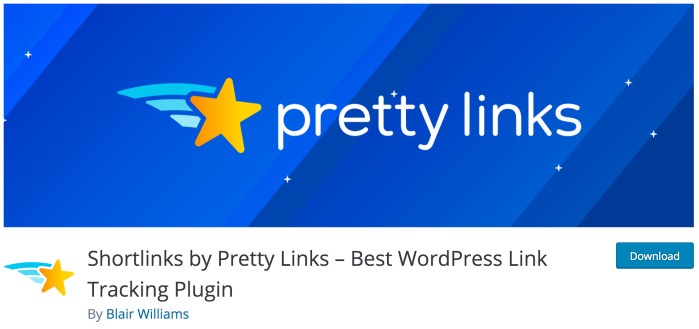
Moreover, sometimes your affiliate partner may change your affiliate link. They may be moving to another affiliate platform or just make other adjustments to their tracking tools.
If you’re using the long default affiliate links, you will need to go and update every single affiliate link on your blog manually. If you have a few dozen affiliate blog posts, that’s going to take a while.
But if you use Pretty Links and you’ve included the short version of your affiliate link in your blog posts, you’ll be done in 1 minute. All you need to do is update your pretty link to lead to the new version.
12: Make it clear you use affiliate links
Last but not least, there’s the legal side of how to get started with affiliate marketing.
Whenever you’re affiliated with a business and earn a commission, make sure that anyone who clicks on your affiliate link knows this.
In the U.S., the Federal Trade Commission (FTC) requires that you let people know whenever you earn a commission.
If you’re being compensated in any way by a company whose product you mention and promote, the FDC disclosure rules apply. No exceptions.
Even if you’re not in the U.S., I strongly recommend you follow this guideline. Your audience will appreciate your honesty and transparency.
Moreover, when disclosing your affiliation, don’t hide your disclosure on a separate page or place it at the end of your blog post. Instead, make your disclosure as close to your affiliate link as possible.
With Blogging Explorer, you can find a disclosure at the beginning of each blog article:

This way, my readers can choose if they want to support me or not. If they decide not to use my link, that’s perfectly OK, too. No hard feelings.
13: Start driving traffic to your content
Once everything is set up, and you’ve published your blog post with your affiliate link, you need to start generating visitors.
You want to get as many eyeballs on your content and drive convinced visitors to your affiliate product’s sales page. After all, if no one reads your content, you won’t make any money!
You can use multiple tools to drive visitors to your blog and to build an engaged audience.
Here are just a few ways to make sure people can find your content and convert into website traffic:
Use email marketing:
Email marketing is one of the most powerful tools you should use for affiliate marketing.
Why?
Because emails are a great way to connect with your readers directly on a more personal level.
Having a list of email subscribers means you have a direct line to their inbox – but only as long as they feel your emails are helpful and valuable.
Whatever you do, remember to build trust and let your audience get to know who you are. Once you’ve earned their trust, they will be ready to take your affiliate product suggestions seriously.
If you already have a list of subscribers, make sure you send a quick message to them. Tell them you’ve just published a new article on a product you love and think they wouldn’t want to miss it.
If you haven’t started building an email list yet, now is the perfect time to start. You should start collecting emails as soon as you launch your blog!
Head over to Mailerlite and set up your first email list for free right away! (Yes, that’s an affiliate link.)
Then, follow my easy beginner’s guide to start an email list for your blog in 7 quick steps.
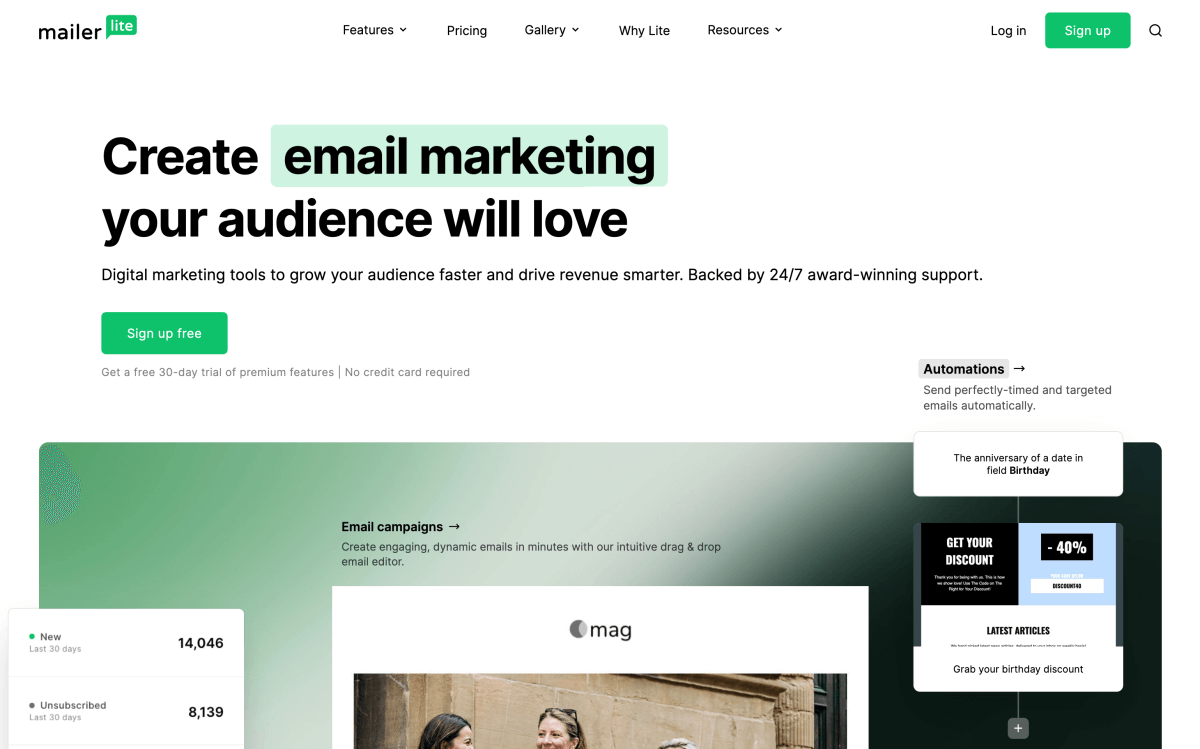
Optimize for search engines with SEO:
SEO or Search Engine Optimization isn’t as difficult as bloggers often think.
SEO is all about understanding what people are searching for and how you can offer them the best possible content.
The best part?
Organic traffic through search engines is 100% free. Also, it ramps up with time. The longer you keep blogging and produce top-notch content, the more traffic you can expect.
If SEO feels like a big mystery, check out my free SEO for beginners guide to learn the basics right away.
A quick way to find out what people are looking for is to do a quick search on Google. Type in a relevant keyword to see what questions people are asking about your affiliate product, for example.
Now, write down all the questions and issues people have. Then, give them the best possible answers in your blog post.
For example, one of my go-to affiliate products is Bluehost’s hosting plans.
When I launched my first blog, I was 100% clueless about how website hosting works. But ever since I started using their blog hosting, I’ve never had to struggle with technical jargon or sleepless nights because of website problems.
So, for my Bluehost tutorial post, I used Google to find out what new bloggers are asking.
I typed in “bluehost wordpress hosting” and found a bunch of popular questions in the People also ask section:
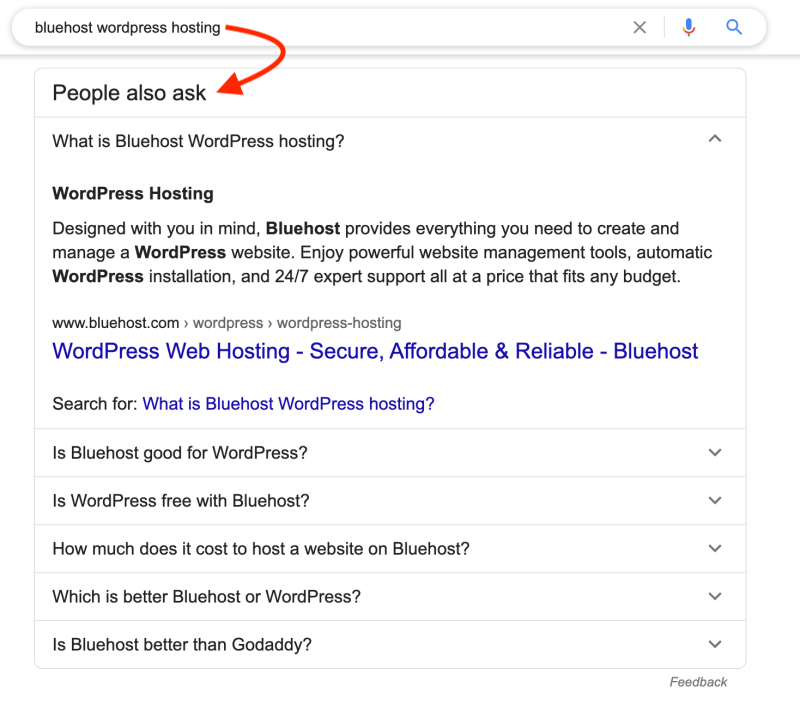
I combined these questions with my own and made sure I’d answer them in my guide.
As a result, I now generate a decent amount of traffic to that blog post, and it’s one of my top money-making articles.
If you’re new to SEO and you’re not sure where to start, don’t worry. You can use the free Yoast SEO plugin in WordPress and optimize your articles super easily.
Yoast analyses your blog posts and gives actionable tips to improve them right away:
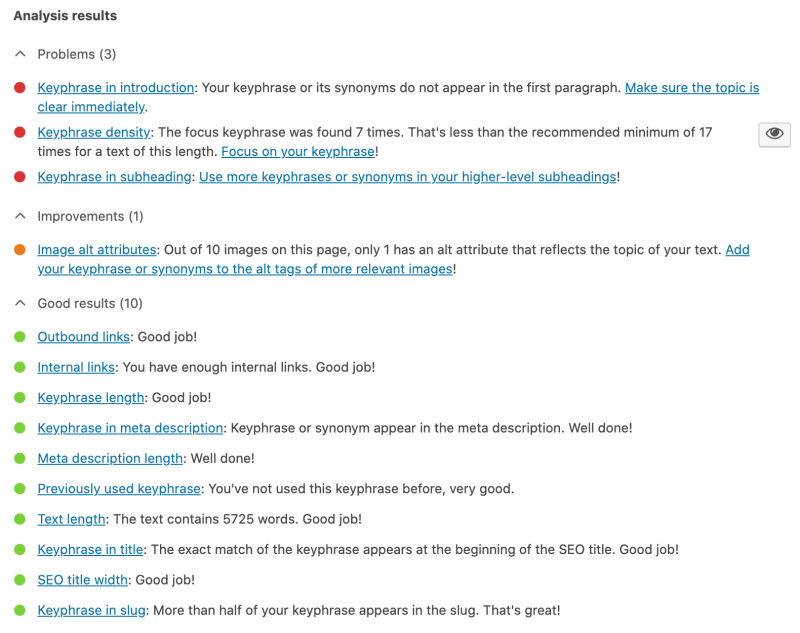
Explode your traffic with Pinterest:
Pinterest is not just another social network. It’s so much more than that!
If you’ve read some of my earlier articles, you know I’m a huge Pinterest junkie. I’ve developed a proven Pinterest marketing strategy that doubled my blog traffic (and affiliate income!) in a matter of weeks.

The reason you should use Pinterest is that it works much faster than SEO. Although you shouldn’t neglect SEO, it takes time for your blog posts to rank well on search engines.
So, if you want to see traffic almost instantly, you want to learn how Pinterest works.
Pinterest has over 400 million monthly users, so you can drive traffic to your blog with any blog topic you can imagine.
People use Pinterest to find ideas and inspiration, which is perfect for suggesting helpful affiliate products to them.
And hey, luckily for you, many bloggers use Pinterest the wrong way. They underestimate its power and use it as a social network, although it’s a search engine.
If you’re new to the platform, make sure you read my beginner’s guide to Pinterest SEO to master Pinterest marketing from day one.
If you want to get a head start into Pinterest traffic, grab your FREE Pinterest Marketing Quick Guide now:
Use social media:
Facebook, Twitter, and Instagram are great tools to promote your affiliate articles, too. Find out which network your target audience uses the most and start building a presence for yourself.
It may take some time until you gain traction. But once your following starts to grow, you will see your affiliate commissions increase faster, too.
For more detailed tips, check out my guide on how to grow your blog traffic quickly.
Summing it up: Affiliate marketing for dummies step-by-step guide
There you go! I hope this affiliate marketing for dummies guide has helped you understand what affiliate marketing is.
You should now feel more comfortable with finding the perfect affiliate programs in your niche, creating excellent content, and generating traffic to your website.
Let’s recap. The 13 steps to becoming a successful affiliate marketer are:
- Choose a popular niche that allows you to sell products.
- Build your self-hosted website.
- Find the brands and products you would recommend to a friend.
- Choose your first affiliate product.
- Focus on a group of products that helps your readers.
- Sign up for the best affiliate programs for your product group.
- Choose your main channel to promote your affiliate products.
- Create valuable, benefit-driven content to promote the products.
- Add further affiliate products to your affiliate portfolio.
- Create a round-up of all affiliate products you recommend.
- Shorten your affiliate links.
- Disclose your affiliation (FTC compliance).
- Start driving traffic to your content.
The bottom line is:
You want to build a loyal audience who loves your content and trusts you. Thus, be honest and transparent with your readers.
Once you have built an audience, nurture the relationship and the trust you’ve created. Start suggesting useful, valuable products that make their lives easier. Share your success stories with these products and make sure not to be salesy.
For a thorough guide to monetize your blog, check out my step-by-step blog post on how to make money blogging for beginners.
Although it may take a while to see substantial income from your affiliate marketing efforts, they will pay off. Trust me.
I know this was a long read, but you’ve made it this far! Congrats!
Before you go out there and launch your affiliate marketing website, I’d love to hear your thoughts! What’s on your mind right now? Questions, feedback, ideas?
Please share your thoughts in the comments below!
P.S. If you liked this free guide to affiliate marketing for dummies, please share it with others!
